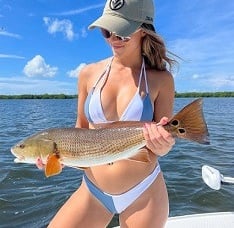How to Catch Redfish in Florida: Expert Tips, Gear, and Techniques
Learn how to catch redfish in Florida’s surf zones with the best tips, gear, and techniques. This guide covers everything from bait selection to advanced fishing strategies.
REDFISH
Kevin
12/24/20243 min read


How to Catch Redfish Surf Fishing in Florida: A Comprehensive Guide
Redfish, also known as red drum, are among the most popular inshore game fish in Florida. Their striking appearance, powerful fight, and delicious flavor make them a favorite for anglers of all experience levels. Catching redfish while surf fishing adds an extra layer of excitement as you battle not just the fish but also the surf and tides. This article dives deep into how to successfully catch redfish surf fishing in Florida, covering techniques for different weather conditions, times of the day, and essential gear recommendations.
Understanding Redfish Behavior
Before diving into techniques, it’s crucial to understand redfish habits:
Habitat: Redfish are commonly found in surf zones, estuaries, and nearshore waters. They often patrol troughs, sandbars, and areas with strong tidal movement.
Diet: These fish primarily feed on shrimp, crabs, mullet, pinfish, and other small baitfish.
Seasons: While redfish can be caught year-round in Florida, they are most active in the spring and fall when water temperatures range between 65°F and 80°F.
Feeding Times: Redfish are most active during low-light conditions like dawn, dusk, and overcast days.
Essential Gear for Surf Fishing Redfish
Rod and Reel:
Rod: A 9- to 12-foot surf rod with medium-heavy power and fast action is ideal for casting long distances and handling big redfish.
Reel: Choose a spinning or baitcasting reel with a robust drag system. Look for a reel size between 4000 and 6000 to hold enough line.
Line:
Use a braided line with a 30-50 lb test for durability and sensitivity.
Attach a fluorocarbon leader of 20-30 lbs to make your setup less visible underwater.
Hooks and Terminal Tackle:
Circle hooks (3/0 to 5/0) are best for redfish as they increase hookup rates and reduce gut-hooking.
Use pyramid sinkers (2-6 ounces) to keep your bait in place in the surf.
Bait Options:
Live Bait: Mullet, shrimp, and crabs.
Cut Bait: Ladyfish, mullet, or pinfish.
Artificial Lures: Soft plastic paddle tails, gold spoons, and topwater plugs.
Accessories:
Sand spikes to secure your rod.
A tackle box with swivels, leaders, and extra sinkers.
A cooler for bait and your catch.
Techniques for Catching Redfish Surf Fishing in Florida
Morning Techniques
Mornings are prime for redfish due to cooler water temperatures and increased baitfish activity.
Location:
Look for sandbars, troughs, and rip currents close to shore. These areas funnel baitfish and attract redfish.
Bait Presentation:
Use live shrimp or finger mullet on a fish-finder rig. The natural movement of live bait will entice redfish.
Casting:
Cast just beyond the breakers to target redfish cruising the troughs.
Retrieve:
Let the bait sit and allow the redfish to find it. Occasionally jigging your rod tip can attract attention.
Midday Techniques
As the sun rises, redfish move to deeper waters or shaded areas.
Weather Considerations:
On hot, sunny days, focus on shaded troughs or cast further out to cooler water.
Cloudy conditions can keep redfish closer to shore.
Bait Selection:
Switch to cut bait like ladyfish or mullet. The strong scent works well when redfish are less active.
Technique:
Use a double-drop rig with two baits to cover more water and increase your chances.
Ensure your sinker is heavy enough to keep your bait stationary in stronger midday currents.
Night Fishing Techniques
Night fishing for redfish is a peaceful yet productive experience, as they feed aggressively in the dark.
Location:
Fish around piers, jetties, and illuminated areas where baitfish gather.
Bait and Lures:
Use cut bait or soft plastic lures with glow-in-the-dark properties.
Lighting:
A headlamp or lantern can help with baiting hooks and detecting bites.
Casting:
Cast closer to shore where redfish come in to hunt in the surf zone.
Retrieve:
Use a slow, steady retrieve if using lures. For cut bait, let it sit and check periodically.
Adapting to Weather Conditions
Calm Days
Use lighter gear for better sensitivity and stealth.
Cast farther out since redfish may be less active near the shore.
Windy Days
Opt for heavier sinkers to hold bait in place.
Target areas with calmer surf, like leeward sides of jetties.
Rainy or Overcast Conditions
Redfish are more likely to patrol closer to shore during overcast days.
Use brightly colored lures for visibility.
Cold Fronts
Fish in deeper troughs and channels where redfish seek warmth.
Use slow-moving baits like live shrimp or crabs.
Tips for Success
Scout Your Location:
Visit potential fishing spots during low tide to identify structure and sandbars.
Use online maps to pinpoint areas with strong tidal movement.
Monitor Tides and Currents:
Incoming tides bring baitfish and attract redfish. Focus your efforts during these periods.
Outgoing tides can also be productive as bait is swept into deeper waters.
Stay Patient:
Redfish are cautious predators. Allow them time to take the bait before setting the hook.
Practice Catch and Release:
Redfish have strict slot limits in Florida (usually 18-27 inches). Handle fish carefully to ensure their survival if released.